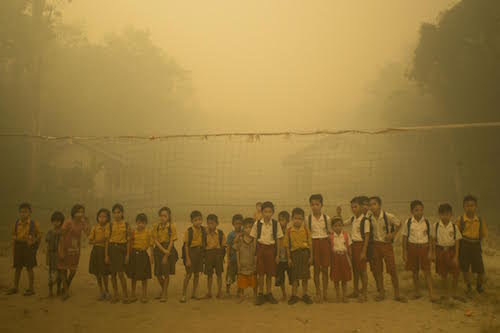An investigation into the transboundary haze and the palm plantations in Indonesia
Patrick Anderson
Using fire to clear forests for plantations is illegal in Indonesia, but the practice is widespread and perpetrators have almost always escaped punishment. Helena Varkkey's book uses a political economy lens to explore the palm oil sector in Indonesia and associated transboundary haze, and finds that regional influences and patronage politics lie at the heart of the industry's rapid expansion and the failed attempts to reduce the haze from forests burnt to establish oil palm plantations.
The Haze Problem in Southeast Asia: Palm Oil and Patronage is a valuable addition to efforts to explore the failure of Indonesia and ASEAN to address forest fires and related haze. Simply put, the billionaires that now own the biggest oil palm companies have been able to use their influence to stop effective policies and enforcement, while hiring former and current government officials into nominal roles, to facilitate their access to development licenses.
Plantation industries have been responsible for 80 per cent of the transboundary haze in recent years. Tens of millions of people in Southeast Asia are affected on an annual basis. In late 2015, fuelled by El Nino, peat fires raged for months with the smoke affecting more than 40 million people. As well as the health costs from the haze, the oil palm industry and its patronage networks have damaged local economies, destroyed millions of hectares of forests and weakened the rule of law.
Varkkey examines the similarities in patronage politics in Singapore, Malaysia and Indonesia. She explores how this shared approach to doing business and politics, helped Singaporean and Malaysian companies to expand in Indonesia, where they now own half of the oil palm sector. At the same time, despite large public outcry about the haze problem, ASEAN's principle of non-interference in national government policies has meant that Indonesia has faced little pressure from its neighbours to stop generating transboundary haze.
The book also explores attempts supported by ASEAN, with Indonesian agreement, to fund haze reduction efforts in Indonesia. However, these efforts failed due to their focus on small farmers, leaving the big companies, which are responsible for most of the haze, off the hook.
The book includes chapters Varkkey wrote and published over the past five years, its coverage ending a year before the devastating fires and haze of late 2015. In one of the final remarks of the book Varkkey notes that it would be interesting to conduct a political economy analysis of Indonesia’s signing in September 2014 of the ASEAN transboundary haze agreement, after 12 years of stalling. Indeed, an analysis of this event, and the responses of Indonesia and the region to the intense haze of 2015 would make a great follow up to this book.
Pressure on the Indonesian government to end patronage politics in natural resource sectors has been growing in recent years, and its Corruption Eradication Commission is making big strides to prosecute government officials taking bribes and kickbacks for issuing oil palm development licenses. In early 2016, the Indonesian president announced a moratorium on clearance of peat forests, and in April he announced a moratorium on use of forest lands for oil palm development. Over the last two years, the biggest oil palm companies in Indonesia, pressured by their customers and investors, have made a public commitment to zero deforestation and studies on the ground are showing their compliance. Despite these efforts, patronage models in Malaysia, Singapore and Indonesia remain potent forces. All actors and groups involved in efforts to protect forests and support the rights of forest peoples in Southeast Asia would benefit by reading the analysis that Helena Varkkey develops in her book.
Patrick Anderson (patrickanderson1960@gmail.com) lives in Canberra and works for the Forest Peoples Programme on forest issues in Southeast Asia.
Inside Indonesia 124: Apr-Jun 2016{jcomments on}
